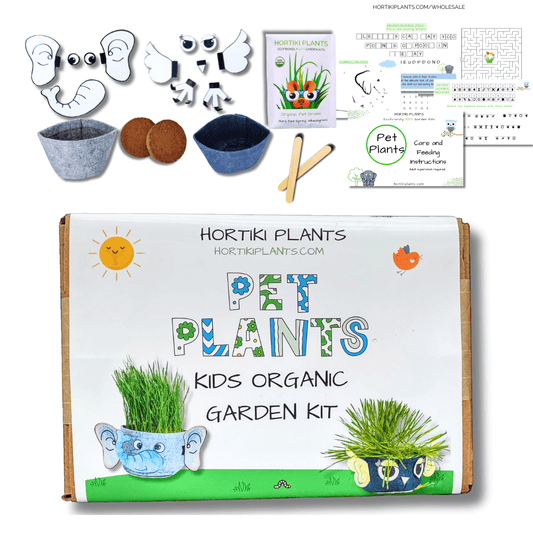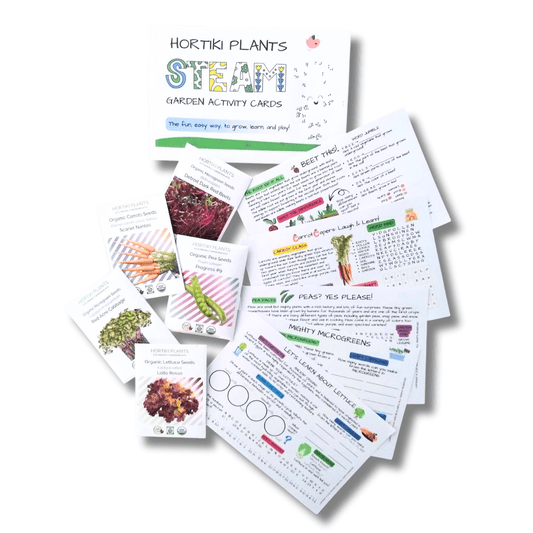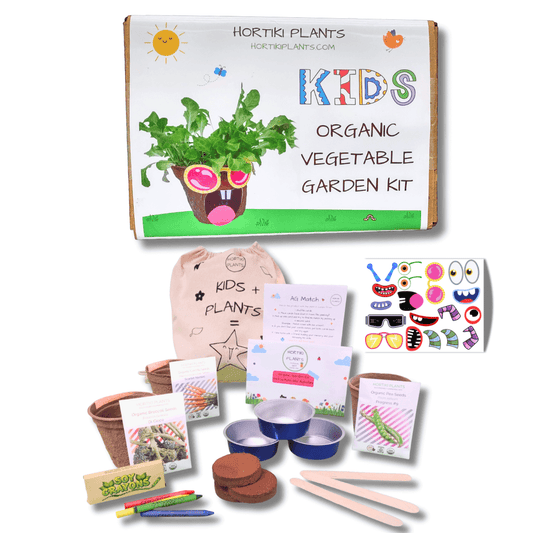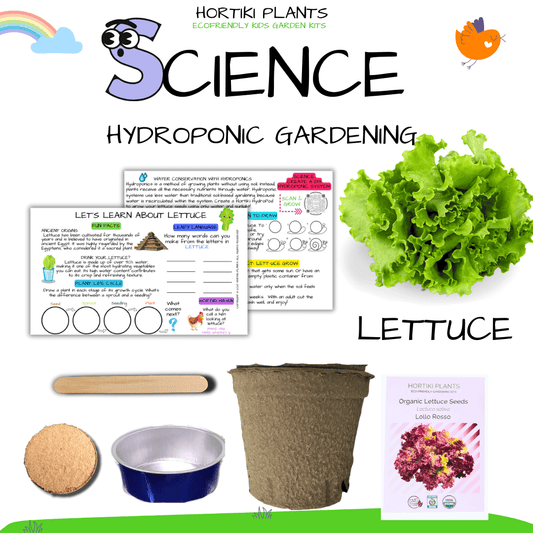Pet Plant to Plate: 5 Surprisingly Tasty Wheatgrass Recipes
 Hello, young gardeners and culinary adventurers! At Hortiki Plants, we are thrilled that you are growing your very own plants with our Pet Plants STEM Garden Kits. The best part of gardening is getting to enjoy the food you've grown. Today, we're going to explore five recipes using the fresh wheatgrass from your garden. Get ready to turn your harvest into some delicious treats!
Hello, young gardeners and culinary adventurers! At Hortiki Plants, we are thrilled that you are growing your very own plants with our Pet Plants STEM Garden Kits. The best part of gardening is getting to enjoy the food you've grown. Today, we're going to explore five recipes using the fresh wheatgrass from your garden. Get ready to turn your harvest into some delicious treats!
A Note on Kitchen Safety 🧑🍳
Cooking is a great adventure, and every adventurer needs a plan to stay safe.
- Always start with clean hands.
- Gently rinse your wheatgrass and any other fresh produce.
- Parents, a friendly note for you: We've highlighted the steps where your supervision or assistance is recommended with a special Grown-up Alert! This is for tasks that involve sharp tools, blenders, or the stove.
Our Commitment to Your Family's Health
At Hortiki Plants, our mission is to support all families on their journey to healthy, happy eating. We recognize that for many, this involves careful planning. With the rise of childhood diabetes and food allergies across the nation, knowing what's in your food is more important than ever. To help, we've made our nutrition information clear and easy to use. Our 'Carb Quick Check' is designed to support families managing diabetes by putting carb counts at a glance. We clearly list common allergens to take the guesswork out of meal prep. Finally, our MyPlate map helps everyone build balanced, nutritious plates. It's all part of our commitment to making gardening and cooking a joyful and accessible experience for every family.
1. Garden Green Smoothie
This smoothie gets its vibrant green color from your freshly grown wheatgrass, blended with the natural sweetness of fruit like bananas and mangoes.
Did You Know? 🍌 Botanically speaking, bananas are considered berries, while strawberries are not! Bananas are also a great source of potassium, an important mineral that helps your muscles work properly.

Serving and Allergen Information:
- Serves: 1
- Allergens: Dairy (if using cow's milk/yogurt), Wheat (from wheatgrass).
Estimated Nutrition Information:
| Nutrient | Amount |
|---|---|
| Calories | 180-220 |
| Protein (g) | 5-7 |
| Fat (g) | 2-4 |
| Carb Quick Check | 35-45 g |
MyPlate Mapping:
| Food Group | Status |
|---|---|
| Fruits | (Fully Met) |
| Vegetables | (Partially Met) |
| Dairy | (Partially Met) |
Ingredients:
- 1/2 cup chopped banana (fresh or frozen)
- 1/2 cup chopped mango (fresh or frozen)
- 1/4 cup fresh wheatgrass, rinsed
- 1/2 cup yogurt (plain or vanilla)
- 1/2 cup milk (dairy or non-dairy)
- Optional: 1-2 teaspoons honey or maple syrup for sweetness
Instructions:
- Grown-up Alert! Carefully snip your wheatgrass from your Pet Plant kit.
- Add the banana, mango, wheatgrass, yogurt, and milk to a blender.
- Grown-up Alert! Secure the lid and blend until smooth. If it's too thick, add a little more milk.
- Pour into a glass and enjoy.
What other fruits could you add to your smoothie to create a new color or flavor?
2. Sunny Wheatgrass Dip with Veggie Sticks
This bright green dip is a creative way to eat more vegetables. It uses cream cheese as a base and gets its color and fresh flavor from your homegrown wheatgrass.
Did You Know? 🥕 The orange carrots we eat today weren't always that color. Hundreds of years ago, most carrots were actually purple or yellow! Orange carrots were cultivated and became popular much later.
Serving and Allergen Information:
- Serves: 4-6
- Allergens: Dairy (from cream cheese), Wheat (from wheatgrass).
Estimated Nutrition Information:
| Nutrient | Amount |
|---|---|
| Calories | 90-110 |
| Protein (g) | 3-5 |
| Fat (g) | 7-9 |
| Carb Quick Check | 4-6 g |
MyPlate Mapping:
| Food Group | Status |
|---|---|
| Vegetables | (Fully Met) |
| Dairy | (Partially Met) |
Ingredients:
- 4 oz cream cheese, softened
- 2 tablespoons fresh wheatgrass, rinsed
- 1 tablespoon fresh lemon juice
- 1/4 teaspoon garlic powder
- A pinch of salt
- Assorted veggie sticks for dipping (carrots, cucumber, bell peppers)
Instructions:
- Grown-up Alert! Carefully snip and rinse your wheatgrass.
- In a small bowl, combine the softened cream cheese, wheatgrass, lemon juice, garlic powder, and salt.
- Grown-up Alert! Use a small food processor or a blender to mix until the wheatgrass is finely chopped and the dip is smooth. If you don't have one, an adult can finely mince the wheatgrass and you can stir everything together well.
- Transfer to a serving bowl and arrange with your favorite veggie sticks.
Besides veggie sticks, what other foods would be good for dipping? Could you try making this dip a different color with another vegetable?
3. Pet Plant Power Bites
These no-bake energy bites are simple to make and provide long-lasting fuel for an afternoon of play. They are packed with oats, which are a source of fiber.
Did You Know? 🌾 Oats are a fantastic source of fiber. Fiber helps your body digest food slowly, which gives you steady, long-lasting energy instead of a quick burst that fades fast.
Serving and Allergen Information:
- Serves: 8-10 bites
- Allergens: Nuts (if using nut butter), Wheat (from wheatgrass).
Estimated Nutrition Information:
| Nutrient | Amount |
|---|---|
| Calories | 120-150 |
| Protein (g) | 4-6 |
| Fat (g) | 7-9 |
| Carb Quick Check | 12-15 g |
MyPlate Mapping:
| Food Group | Status |
|---|---|
| Grains | (Fully Met) |
| Protein Foods | (Partially Met) |
| Vegetables | (Partially Met) |
Ingredients:
- 1 cup rolled oats
- 1/2 cup nut butter (peanut butter, almond butter, or sunflower seed butter for nut-free)
- 1/4 cup honey or maple syrup
- 2 tablespoons fresh wheatgrass, finely chopped (Grown-up Alert! for chopping)
- 1 tablespoon chia seeds (optional)
Instructions:
- In a medium bowl, combine the oats, nut butter, honey or maple syrup, finely chopped wheatgrass, and chia seeds (if using).
- Stir everything together with a spoon until well combined and sticky.
- Roll the mixture into small, bite-sized balls.
- Place the bites on a plate and refrigerate for at least 30 minutes to help them firm up.
If you could invent your own power bite, what two ingredients would you add to the oats and nut butter?
4. Sprout Sandwich Swirls
These sandwich swirls use wheatgrass to turn cream cheese a bright green, creating a colorful pattern when the sandwich is rolled and sliced.
Did You Know? 🍞 The very same seeds you used to grow your wheatgrass can also grow into tall wheat plants. If you let them grow for a whole season, they would produce grains at the top. Those grains are harvested and ground into the flour used to make bread!

Serving and Allergen Information:
- Serves: 2-3
- Allergens: Wheat (from bread, wheatgrass), Dairy (from cream cheese).
Estimated Nutrition Information:
| Nutrient | Amount |
|---|---|
| Calories | 180-200 |
| Protein (g) | 7-9 |
| Fat (g) | 8-10 |
| Carb Quick Check | 18-22 g |
MyPlate Mapping:
| Food Group | Status |
|---|---|
| Grains | (Fully Met) |
| Vegetables | (Partially Met) |
| Dairy | (Partially Met) |
Ingredients:
- 2 slices whole wheat bread
- 2 tablespoons cream cheese, softened
- 1 tablespoon fresh wheatgrass, finely chopped (Grown-up Alert! for chopping)
- Optional: a few thin slices of cucumber or shredded carrot
Instructions:
- In a small bowl, mix the softened cream cheese with the finely chopped wheatgrass until it's evenly green.
- Grown-up Alert! Carefully use a rolling pin to flatten the bread slices.
- Spread an even layer of the green cream cheese mixture over each flattened bread slice.
- If using, lay a few slices of cucumber or shredded carrot over the cream cheese.
- Starting from one end, carefully roll up each slice of bread tightly.
- Grown-up Alert! Use a sharp knife to slice each rolled-up sandwich into 3-4 "swirls."
- Arrange your swirls on a plate.
What other colorful vegetables could you add inside your swirls to make a rainbow pattern?
5. Green Garden Pancakes
These pancakes use wheatgrass to add vitamins, minerals, and a surprising green color to a breakfast classic.
Did You Know? 🧑🔬 The baking powder in this recipe is what makes the pancakes light and fluffy! When it mixes with wet ingredients and gets warm on the pan, it creates tiny bubbles of carbon dioxide gas. These bubbles get trapped in the batter and make the pancakes rise.
Serving and Allergen Information:
- Serves: 2 (about 4 small pancakes)
- Allergens: Wheat (from flour, wheatgrass), Dairy (if using cow's milk), Egg.
Estimated Nutrition Information:
| Nutrient | Amount |
|---|---|
| Calories | 250-280 |
| Protein (g) | 8-10 |
| Fat (g) | 7-9 |
| Carb Quick Check | 40-45 g |
MyPlate Mapping:
| Food Group | Status |
|---|---|
| Grains | (Fully Met) |
| Dairy | (Partially Met) |
| Vegetables | (Partially Met) |
| Protein Foods | (Partially Met) |
Ingredients:
- 1/2 cup all-purpose flour
- 1 teaspoon baking powder
- 1 tablespoon sugar
- A pinch of salt
- 1/2 cup milk (dairy or non-dairy)
- 1 egg
- 1 tablespoon oil, plus more for cooking
- 2 tablespoons fresh wheatgrass, finely chopped (Grown-up Alert! for chopping)
Instructions:
- In a medium bowl, whisk together the flour, baking powder, sugar, and salt.
- In a separate small bowl, whisk together the milk, egg, and 1 tablespoon of oil.
- Pour the wet ingredients into the dry ingredients and stir gently until just combined. A few lumps are okay!
- Stir in the finely chopped wheatgrass.
- Grown-up Alert! Heat a lightly oiled non-stick pan or griddle over medium heat.
- Grown-up Alert! Pour about 1/4 cup of batter per pancake onto the hot pan.
- Cook for 2-3 minutes per side, or until golden brown and cooked through.
- Serve with your favorite toppings like fruit or a tiny drizzle of maple syrup!
How is a green pancake different from the pancakes you usually eat? What other healthy ingredients could you use to change the color of your food?
Keep Growing, Keep Cooking! 🌱
We hope you had a wonderful time transforming your homegrown wheatgrass into these dishes! Cooking with ingredients you've grown yourself is a rewarding experience, connecting you to where your food comes from.
We would love to see your culinary creations! Share photos of your meals on Instagram and tag us @hortikiplants.
Want to learn more about gardening and food?
Here are some great books for young readers:
Ages 4-7:
- "Planting a Rainbow" by Lois Ehlert
- "The Tiny Seed" by Eric Carle
- "Growing Vegetable Soup" by Lois Ehlert
Ages 8-11:
- "Compost Stew: An A to Z Recipe for the Earth" by Mary McKenna Siddals
- "National Geographic Kids: We Love Our Garden!" by Cynthia Harrison
- "From Seed to Plant" by Gail Gibbons
Find more activities, gardening tips, and exciting products like our Pet Plants STEM Garden Kits on the Hortiki Plants blog and in our shop. Happy growing and happy cooking!



